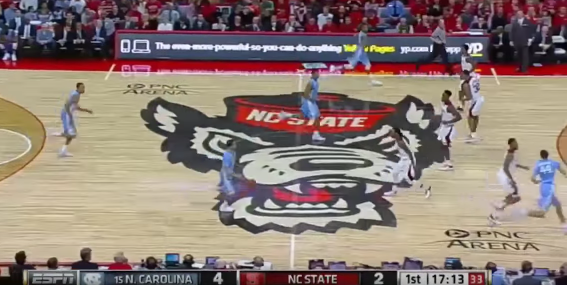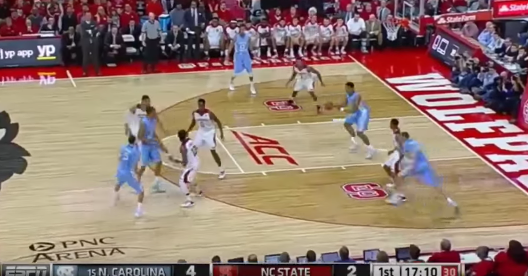The secondary break is more a philosophy than it is a play type for UNC basketball. It may not (yet) have a Chapel Hill-based restaurant named after it, like the Four Corners, but it’s synonymous with North Carolina. Dean Smith started it, and under Roy Williams, several of North Carolina’s more prolific offenses in recent memory have relied heavily on the break.
It’s the opposite of complicated; this isn’t the Golden State Warriors’ whirring motion offense. This is like a football team that runs a pro-style offense — think Alabama; the thought is, if you have superior talent, all you have to do is line up and run right at your opponent. They can’t guard everything.
What’s a secondary break?
It’s a form of transition offense that can take place after a rebound, steal or even a made basket. The initial action is to get the ball in the hands of the point guard. That player is tasked with pushing the ball up the floor with an accelerated pace — don’t let the defense set, exploit cross-matches.
While the ball-handler does this, the two wing players — usually the team’s top shooters — sprint the edges of the court and fill outside lanes on the two opposite sides of the floor. For the 2009 team, this was Wayne Ellington and Danny Green — two marksmen who have continued this craft in the professional ranks for a lot of money. That season, both of those guys shot above 41 percent from downtown on more than 4.5 attempts per game. In 2005, Rashad McCants filled that role; the 2017 title team feature ACC Player of the Year Justin Jackson hunting for three-pointers in semi-transition.
One of the two big men is responsible for running the pipe; this means he has to fill the lane and get to the strong-side block. If he smokes his defender down the floor, it’s an easy two points or maybe even a foul as his man hastily tries to recover. Additionally, his sprint has gravity. The run to the hoop draws attention from the defense, which can free up those shooters for juicy catch-and-shoot bombs.
And last, but certainly not least, is the trailer. That player will run the weak-side, and provide a passing outlet for the point guard. In the past, that player would look to get to the elbow and try to work that pinch post area. However, as basketball becomes more of a spread game, it’s better to stay high, above the arc. This provides an option for ball reversals.
Unsurprisingly, it’s a serious boon, too, if that player can stretch the floor with a jump shot. Perhaps this is a slot we could see Luke Maye excel in next season. In 2005, the role belonged to Jawad Williams or Marvin Williams, who combined to splash 59 three-pointers that season.
How does UNC basketball use the secondary break?
Well, the Tar Heels are the forefathers of the secondary break. So the way they run it is essentially the most common practice. But let’s see how it looks when they first hit the break.
Here’s a picture from a 2015 game against NC State. On the near side, Justin Jackson runs the wing; on the weak side, J.P. Tokoto does the same. Marcus Paige, with the ball, dribbles in the middle of the floor.
Kennedy Meeks, at the time a sophomore, runs the lane while Brice Johnson trails behind the play. Initially, NC State has all of its bases covered. Or so it seems. As the play develops, though, things break, quickly. Johnson approaches Paige to run a pick-and-roll; Kyle Washington and Abdul-Malik Abu fail to communicate who to pick up. (Remember that thing above about cross-matches?)
Both defenders lift up to stymie the ball-screen action, which leaves Meeks wide open under the hoop for an easy dunk.
This is just one of the initial options. The break can also be used to trigger the offense. North Carolina will pass the ball to the strong-side wing, who will look for an entry pass to the block. If that isn’t there, the ball can be reversed, and that’s where UNC can feast from the pinch post.
A look ahead for the reigning champs
No matter what, UNC will run a ton of secondary break action in 2017-18. It doesn’t matter who is or isn’t on the roster. If Tony Bradley had returned, he would’ve fit nicely as the rim-runner; however, that option is out the door. Someone else will have to fill the void.
Maye should function nicely as the trailer; he started to find a niche this season as a stretch-4.
Joel Berry is the most seasoned point guard in college basketball; it will be his show to run in Chapel Hill. However, Theo Pinson has yet to add a three-point shot to his arsenal. Kenny Williams started last season sizzling from deep; however, he cooled off considerably before a season-ending knee injury in February. Roy Williams may need to shuffle the lineup and let Pinson push the pace occasionally so UNC can leverage Berry’s shooting brilliance on the wing.
According to Synergy Sports, Berry shot 40.8 percent on catch-and-shoots in 2016-17. He scored 1.22 points per possession in those situations (No. 7 in the ACC among players with at least 100 possessions), thanks to an adjusted field-goal rate of 61.1 percent.
That vast majority of Berry’s transition possessions, per Synergy, came as the ball-handler. He shot an impressive 53.1 percent on said possessions — most of which were of the two-point variety (0.91 points per possession). When Berry was a shooter from the wing in transition, he connected on 48.3 percent of his attempts — 1.22 points per possession. Those shots from the wing present a higher expected gain; UNC will want to find him more of those possessions.
Sophomore Seventh Woods presents an intriguing option, too. He struggled at times this past season but has the jets and pass-first mentality to make things happen. Per Synergy, Woods turned the ball over less frequently in transition than in the half court.
If things break fortunately for UNC with regard to Cameron Johnson, then he’d function perfectly as one of the wings in this action, too.
Inside the Playbook series
Kyle Guy and the pindown screen
Joel Berry, Luke Maye and pick-and-pop madness
Georgia Tech basketball’s back cut mastery
Duke basketball and the increasingly popular DHO



















